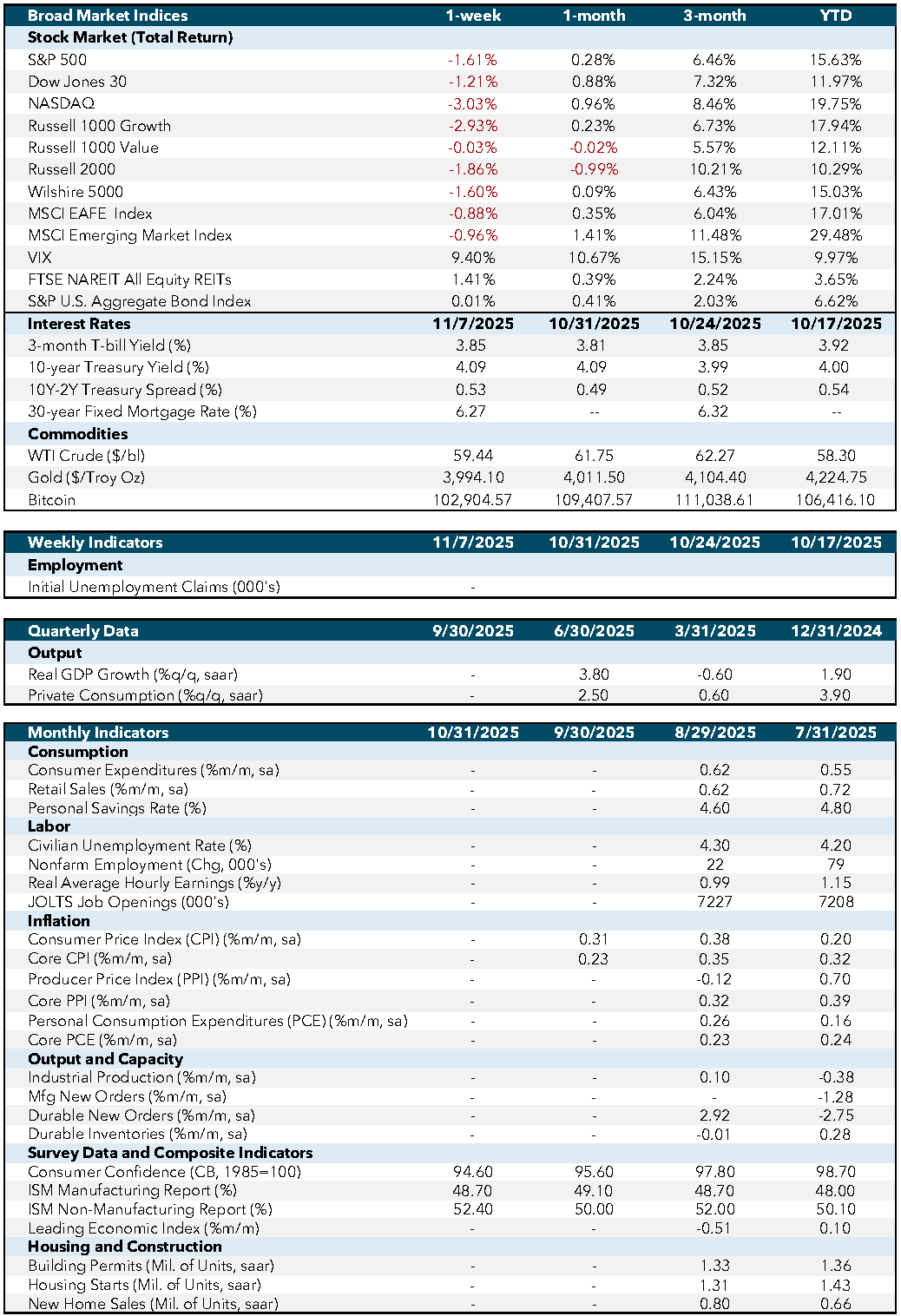Weekly Market Commentary
November 10th, 2025
Week in Review…
Markets absorbed a week of mixed signals, with strength in headline data masking underlying fragility and inflation trends complicating the path forward.
Labor Growth: Resilience in Headlines, Fragility Underneath
With the nonfarm payrolls report delayed, the ADP National Employment Report became the primary labor gauge. The headline numbers beat expectations, offering initial relief. However, gains were concentrated in large firms, while small and mid-sized businesses cut jobs. Despite strong headline figures, underlying labor market conditions showed signs of fragility and lacked broad-based support.
Sentiment Divergence: Services Strong, Manufacturing Weak
ISM surveys revealed a growing split in economic momentum. Manufacturing Purchasing Managers’ Index (PMI) fell deeper into contraction, signaling continued industrial weakness. In contrast, Services PMI expanded at its fastest pace since early 2023, driven by strong new orders and business activity. This resilience in services provided key market support.
Notably, the Services Employment Index remained in contraction but posted its first meaningful improvement in five months, suggesting service-sector job cuts may be slowing — a small but important sign of stabilization.
Inflationary Warnings: A Complex Price and Expectation Picture
Inflation remains the most concerning macro signal. The ISM Services Prices Paid index surged to 70.0%, its highest since October 2022, pointing to rising cost pressures in the dominant services sector. Meanwhile, the Manufacturing Prices Paid index eased, highlighting a cooling in goods inflation. This bifurcation underscores a key challenge: while goods inflation is moderating, services inflation, which is more persistent and harder to tame, is heating up.
Consumer expectations echoed this tension. The University of Michigan survey showed 1-year inflation expectations rising above forecasts, while 5-year expectations declined, suggesting longer-term inflation remains anchored. These dynamics complicate the Fed’s path to rate cuts and may keep short-term Treasury yields elevated.
Peripheral Indicators and Consumer Signals
- Consumer sentiment fell to a three-year low, hinting at weakening confidence and potential spending slowdown
- Consumer credit rose sharply, possibly reflecting short-term borrowing amid fiscal uncertainty
- Crude inventories posted a surprise surplus, signaling cooling demand and potential relief in energy prices
Week Ahead…

With the government shutdown continuing to limit official economic data, markets will turn to alternative sources for insight. Though the calendar is light, the few scheduled releases carry outsized importance, particularly those tied to global energy trends and small business sentiment.
A dominant theme this week will be oil supply and demand, with major reports from OPEC and the International Energy Agency (IEA). These monthly publications offer detailed analysis of global crude market dynamics and will be closely watched for any revisions to demand forecasts and as a proxy for broader economic activity, especially in manufacturing and travel. Domestically, the weekly crude oil inventory report will provide a near-term snapshot of U.S. supply. After last week’s unexpected inventory build, markets will look for confirmation of a cooling demand trend, which could influence price action and reinforce cautious sentiment around industrial consumption.
The NFIB Small Business Optimism Index will also be closely watched. This release is particularly relevant following ADP employment data, which showed job growth concentrated in large firms while smaller businesses reduced headcount. The NFIB reading will help clarify whether this hiring slowdown reflects economic pessimism, financial strain, or strategic shifts toward efficiency — potentially driven by technology adoption. Regardless of the cause, the index will offer valuable insight into hiring intentions within a critical segment of the U.S. economy.
Finally, scheduled Treasury auctions for 3-year, 10-year, and 30-year maturities will provide fresh signals on debt demand and yield curve dynamics. Investor appetite for long-duration bonds will be closely monitored, especially in the absence of traditional data, as it reflects market expectations for inflation, risk, and monetary policy direction.
Economic Indicators:
- CPI: Consumer Price Index measures the average change in prices paid by consumers for goods and services over time. Source: Bureau of Labor Statistics.
- Core CPI: Core Consumer Price Index excludes food and energy prices to provide a clearer picture of long-term inflation trends. Source: Bureau of Labor Statistics.
- PPI: Producer Price Index measures the average change in selling prices received by domestic producers for their output. Source: Bureau of Labor Statistics.
- Core PPI: Core Producer Price Index excludes food and energy prices to provide a clearer picture of long-term inflation trends. Source: Bureau of Labor Statistics.
- PCE: Personal Consumption Expenditures measure the average change in prices paid by consumers for goods and services. Source: Bureau of Economic Analysis.
- Core PCE: Core Personal Consumption Expenditures exclude food and energy prices to provide a clearer picture of long-term inflation trends. Source: Bureau of Economic Analysis.
- Industrial Production: Measures the output of the industrial sector, including manufacturing, mining, and utilities. Source: Federal Reserve.
- Mfg New Orders: Measures the value of new orders placed with manufacturers for durable and non-durable goods. Source: Census Bureau.
- Durable New Orders: Measures the value of new orders placed with manufacturers of durable goods. Source: Census Bureau.
- Durable Inventories: Measures the value of inventories held by manufacturers for durable goods. Source: Census Bureau.
- Consumer Confidence (CB, 1985=100): Measures the degree of optimism that consumers feel about the overall state of the economy and their personal financial situation. Source: Conference Board.
- ISM Manufacturing Report: Measures the economic health of the manufacturing sector based on surveys of purchasing managers. Source: Institute for Supply Management.
- ISM Non-Manufacturing Report: Measures the economic health of the non-manufacturing sector based on surveys of purchasing managers. Source: Institute for Supply Management.
- Leading Economic Index: Measures overall economic activity and predicts future economic trends. Source: Conference Board.
- Building Permits (Mil. of Units, saar): Measures the number of new residential building permits issued. Source: Census Bureau.
- Housing Starts (Mil. of Units, saar): Measures the number of new residential construction projects that have begun. Source: Census Bureau.
- New Home Sales (Mil. of Units, saar): Measures the number of newly constructed homes sold. Source: Census Bureau.
- SA: Seasonally adjusted.
- SAAR: Seasonally adjusted annual rate.
Market Indices & Indicators:
- S&P 500: A market-capitalization-weighted index of 500 leading publicly traded companies in the U.S., widely regarded as one of the best gauges of large U.S. stocks and the stock market overall.
- Dow Jones 30: Also known as the Dow Jones Industrial Average, it tracks the share price performance of 30 large, publicly traded U.S. companies, serving as a barometer of the stock market and economy.
- NASDAQ: The world’s first electronic stock exchange, primarily listing technology giants and operating 29 markets globally.
- Russell 1000 Growth: Measures the performance of large-cap growth segment of the U.S. equity universe, including companies with higher price-to-book ratios and growth metrics.
- Russell 1000 Value: Measures the performance of large-cap value segment of the U.S. equity universe, including companies with lower price-to-book ratios and growth metrics.
- Russell 2000: A market index composed of 2,000 small-cap companies, widely used as a benchmark for small-cap mutual funds.
- Wilshire 5000: A market-capitalization-weighted index capturing the performance of all American stocks actively traded in the U.S., representing the broadest measure of the U.S. stock market.
- MSCI EAFE Index: An equity index capturing large and mid-cap representation across developed markets countries around the world, excluding the U.S. and Canada.
- MSCI Emerging Market Index: Captures large and mid-cap representation across emerging markets countries, covering approximately 85% of the free float-adjusted market capitalization in each country.
- VIX: The CBOE Volatility Index measures the market’s expectations for volatility over the coming 30 days, often referred to as the “fear gauge.”
- FTSE NAREIT All Equity REITs: Measures the performance of all publicly traded equity real estate investment trusts (REITs) listed in the U.S., excluding mortgage REITs.
- S&P U.S. Aggregate Bond Index: Represents the performance of the U.S. investment-grade bond market, including government, corporate, mortgage-backed, and asset-backed securities.
- 3-Month T-bill Yield (%): The yield on U.S. Treasury bills with a maturity of three months, reflecting short-term interest rates.
- 10-Year Treasury Yield (%): The yield on U.S. Treasury bonds with a maturity of ten years, reflecting long-term interest rates.
- 10Y-2Y Treasury Spread (%): The difference between the yields on 10-year and 2-year U.S. Treasury bonds, often used as an indicator of economic expectations.
- WTI Crude ($/bl): The price per barrel of West Texas Intermediate crude oil, a benchmark for U.S. oil prices.
- Gold ($/Troy Oz): The price per troy ounce of gold, a standard measure for gold prices.
- Bitcoin: A decentralized digital currency without a central bank or single administrator, which can be sent from user to user on the peer-to-peer bitcoin network.
This content was developed by Cambridge from sources believed to be reliable. This content is provided for informational purposes only and should not be construed or acted upon as individualized investment advice. It should not be considered a recommendation or solicitation. Information is subject to change. Any forward-looking statements are based on assumptions, may not materialize, and are subject to revision without notice. The information in this material is not intended as tax or legal advice.
Investing involves risk. Depending on the different types of investments there may be varying degrees of risk. Socially responsible investing does not guarantee any amount of success. Clients and prospective clients should be prepared to bear investment loss including loss of original principal. Indices mentioned are unmanaged and cannot be invested into directly. Past performance is not a guarantee of future results.
The Dow Jones Industrial Average (DJIA) is a price-weighted index composed of 30 widely traded blue-chip U.S. common stocks. The S&P 500 is a market-cap weighted index composed of the common stocks of 500 leading companies in leading industries of the U.S. economy. The NASDAQ Composite Index is a market-value weighted index of all common stocks listed on the NASDAQ stock exchange.
Securities offered through Cambridge Investment Research, Inc., a broker-dealer, member FINRA/SIPC, and investment advisory services offered through Cambridge Investment Research Advisors, Inc., a Registered Investment Adviser. Both are wholly-owned subsidiaries of Cambridge Investment Group, Inc. V.CIR.1125-4146
For financial professional use only.

